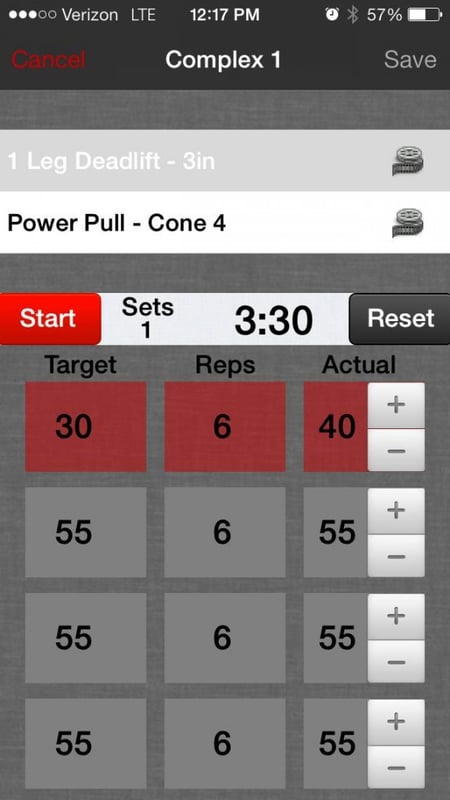
An Australian pro rugby coach and I discussed why some unexpected athletes were progressing on his program. In this particular situation, the coach had defined his prescription for the athlete as having 3 work sets. Of the prescribed 6 sets total for this exercise, 3 were warm-up sets to prepare and maximize the performance in the final 3 work sets.
Via the app, the athlete recorded his first work set as a lower weight than the goal for the current level. However, his other 2 work sets were above the goal weight for the day, making his average weight for the 3 sets sufficient for progression. This meritocracy, is critical in building better consistency and subsequent superior training results, but first requires a clear definition of how you evaluate each training session, particularly utilizing the average performance.
So the first step in defining the exercise stimulus is to average the work sets. We focus on work sets, because warm-up set performances have massive unreliability primarily because of psychological factors (the focus on cues early in workout, tentative on a new exercise, etc.) and to a lesser extent, physical factors such as soreness from the previous day. The first step is to decide what to average within the work sets.
The calculation of a training load in resistance training is agreed upon by most coaches; the product of sets x repetitions x intensity (weight). At Sparta, we use goals based off % body weight instead of 1 RM because of its greater reliability, as well as a large respect for the “skill” required to lift a heavy weight for just 1 repetition. We use this 1 RM mentality for all of skills, including sprints and agility as the intensity is gauged by % off the athlete’s personal best. Regardless of nomenclature or philosophy, the merit, is just a number to give the training a benchmark.
But we cannot look at this average, or any data point, in isolation, as this single point lacks both history (better or worse than last week?), and future (the resultant stimulus response on the next session). The best, and simplest lesson, we have learned from the statisticians reviewing our data is the value of percent change over time. Rather than looking at one session or absolute values, the statisticians compare our force plate variable changes to our prescription changes.
A March 2013 study out of the Sport Performance Research institute in New Zealand used another name for calculating merit: the mean intensity relative volume (IRV). Being a systematic review, the authors had to find a way to measure the percent changes amongst 27 different studies and varying movements. So the authors normalized percent change values between training sessions via two methods:
1. Weekly changes
Training frequencies were compared by dividing the percent change by the study duration. So an improvement in an athlete’s squat weight by 20 kilos in 4 weeks, was calculated as a weekly 5% change.
2. Change per training workout
Individual workout changes were then compared by dividing by the product of the training frequency and duration. In the above squat example, an athlete training 2 times a week had a workout change of 2.5%; a 20 kilo increase divided by 8 (4 weeks of 2 times a week). While an athlete training 4 times a week had an increase of only 1.25% per workout.
Most of our discussion has focused on traditional bilateral resistance training, such as squats, cleans, etc., but IRV becomes lacking when we evaluate unilateral movements whose volume (sets x repetitions) becomes very high. The IRV then cannot be equated with higher intensity, lower volume movements like the deadlift as shown below
3 sets of 10 reps at 50 kilo Single Leg Deadlift = 1500 units (IRV)
3 sets of 5 reps at 100 kilo Deadlift = 1500 units
You can certainly choose one side each set and solve the problem, but the problem is not entirely solved since the movements are drastically different. There is no single metric to compare the different merits, especially when the issue is expounded to all movement, such as sprinting and agility. Therefore, we separate out the 3 most important variables (intensity, volume, rest) and combine a unique combination into one loading scheme.
For example, our HEAVY loading scheme uses the same rest period and volume for both squat and deadlift, with a percentage of bodyweight applied to suit the movement, volumes, and rest. This loading scheme’s is then a fixed factor to more accurately calculate the percent changes against a more desirable, yet variable outcome. In our case this outcome is either the Movement Signature change or the sport performance itself (change in ERA, etc.).
Define your scheme and stick to it because while lifting heavy is a huge benefit, the change in the weight is not the most important outcome.
McMaster DT, Gill N, Cronin J, McGuigan M. The development, retention and decay rates of strength and power in elite rugby union, rugby league and American football: a systematic review. Sports Med. 2013 May;43(5):367-84.